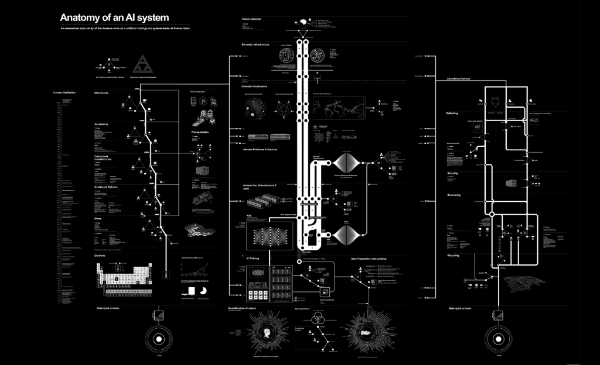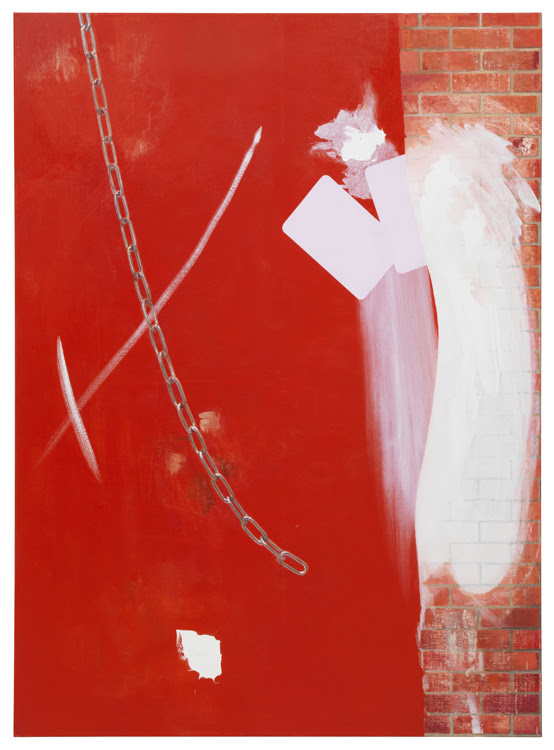MATERIAL UNDERSTANDING
The full resource stack needed for Amazon’s Echo to “turn on the lights”

In a novel new project, KATE CRAWFORD and VLADAN JOLER present an “anatomical case study” of the human labor, data, and planetary resources necessary for the functioning of an Amazon Echo. A 21-part essay accompanies an anatomical map (pictured above), making the case for the importance of understanding the complex resource networks that make up the “technical infrastructures” threaded through daily life:
“At this moment in the 21st century, we see a new form of extractivism that is well underway: one that reaches into the furthest corners of the biosphere and the deepest layers of human cognitive and affective being. Many of the assumptions about human life made by machine learning systems are narrow, normative and laden with error. Yet they are inscribing and building those assumptions into a new world, and will increasingly play a role in how opportunities, wealth, and knowledge are distributed.
The stack that is required to interact with an Amazon Echo goes well beyond the multi-layered ‘technical stack’ of data modeling, hardware, servers and networks. The full stack reaches much further into capital, labor and nature, and demands an enormous amount of each. Put simply: each small moment of convenience – be it answering a question, turning on a light, or playing a song – requires a vast planetary network, fueled by the extraction of non-renewable materials, labor, and data. The scale of resources required is many magnitudes greater than the energy and labor it would take a human to operate a household appliance or flick a switch.”
Link to the full essay and map.
- More on the nuanced ethical dilemmas of digital technology: “Instead of being passive victims of (digital) technology, we create technology and the material, conceptual, or ethical environments, possibilities, or affordances for its production of use; this makes us also responsible for the space of possibilities that we create.” Link.
- As shared in our April newsletter, Tim Hwang discusses how hardware influences the progress and development of AI. Link.
WIDE OPEN FIELD
The beginnings of bioethics
Advances in data-gathering, machine learning, and algorithmic decision-making systems are opening up difficult political, ethical, and legal questions. In the 1960s and 1970s, medicine was forced to address similarly discipline-shifting questions. Technological advances—and corresponding high-profile media coverage and court cases—led to the birth of bioethics.
From David J. Rothman’s “Strangers at the Bedside: A History of How Law and Bioethics Transformed Medical Decision Making”:
“The critical period of change was 1966 to 1976. The transformation began when in 1966 a Harvard Medical School professor, Henry Beecher, exposed abuses in human experimentation. Then, in 1973, Congress, under the leadership of senators Walter Mondale and Edward Kennedy, established a national commission to explore medical ethics. The period closed with the New Jersey Supreme Court ordering doctors to yield to parental requests to remove twenty-two-year-old Karen Ann Quinlan from a respirator. The impact of these events, most generally framed, was to make the invisible visible. Outsiders to medicine—that is, lawyers, judges, legislators, and academics—penetrated its every nook and cranny, in the process giving medicine an exceptional prominence on the public agenda and making it the subject of popular discourse. This glare of the spotlight transformed medical decision making, shaping not merely the external conditions under which medicine would be practiced (something that the state, through the regulation of licensure, had always done), but the very substance of medical practice—the decisions that physicians made at the bedside.”
Link to a preview on Google Books.
- The Hastings Center, whose founder Daniel Callahan is a key voice in the field, tells a consonant story: “From the first it was understood that bioethics had to cast a wide net, moving from the most intimate doctor-patient encounters at the bedside to the most public kinds of decisions on the provision of health care. Good ethics in that context meant working at both ends of a spectrum: a serious grappling with basic issues of human nature, rights, and dignity—where should medicine be taking us?—and dealing with the most practical of policy matters.” Link.
- “The mediators came, almost all of them, from the traditional disciplines of theology and philosophy. There were a few physicians, a few lawyers, and an occasional social scientist, but early bioethics was fashioned out of bits and pieces from moral philosophy and moral theology.” From a compilation of reflections on the birth of the field. Link.
- A 2009 article from Mark Rothstein: “The Role of Law in the Development of American Bioethics.” Link.
+++
- From IBM, an open-source toolkit for fostering fairness in AI: “Containing over 30 fairness metrics and 9 state-of-the-art bias mitigation algorithms developed by the research community, it is designed to translate algorithmic research from the lab into the actual practice of domains as wide-ranging as finance, human capital management, healthcare, and education.” Link to the toolkit, link to a blog post introducing the project, and link to a developers tutorials page with interactive Jupyter notebooks detailing the toolkit’s potential application for examining credit scoring, medical expenditure, and gender bias in face classifiers.
- A look at the long-term relationship between capital shares and income inequality. Link.
- Researchers Guy Abel and Nikola Sander quantify (for the first time) bilateral migration flows between the world’s 196 countries from 1990-2010. Link to their paper, link to their data.
- A recent paper by Nichola Bianchi and Michela Giorcelli examines the lasting effects of international reconstruction aid on long-term economic growth in Italy. From the abstract: “Provinces that received more reconstruction grants experienced an increase in the number of industrial firms and workers. The same provinces experienced a faster mechanization of the agricultural sector. Reconstruction grants induced economic growth by allowing Italian provinces to modernize their transportation and communication networks damaged during WWII.” Link. And link to a summary post at ProMarket.
- The Crimean War, land and rail speculation, and a crisis in Europe. “What caused the panic of 1857?” Link.
- A recent paper by Carolina Arteaga of graduates from Colombia’s top university tests whether returns to higher education are the result of human capital accumulation or signaling effects. The results “suggest that human capital plays an important role in the determination of wages and reject a pure signaling model.” Link.
- An Economic Anatomy of Optimal Climate Policy.” Link. Relatedly, Jason Hickel in Foreign Policy: “Why Growth Can’t Be Green.” Link. (More on this next week.)
- On the history of simulations in economics: “What is striking about the whole simulation movement is the desire to use artificial means to create a stream of outputs which look like the real observations we get from the world, i.e. to create “evidence” which will match or mimic the empirical or real evidence. Boumans suggests that whether we can interpret or treat such “evidence” from model experiments as real evidence is a kind of Turing test in economics.” Link.
- Published in Nature, new research by Moe Vazifeh at MIT’s Senseable City Lab models how to best size and operate a taxi fleet in New York City. Link.
- On the liquidity of the Victorian capital market. Link.
- Major new working paper on intergenerational mobility in India. Link to the paper. And link to an introductory thread from co-author Paul Novosad, which includes a link to their methods paper, illuminating how mobility is calculated “in developing countries when you don’t have linked income data and education is super coarse.”
Filed Under
Each week we highlight research from a graduate student, postdoc, or early-career professor. Send us recommendations: editorial@jainfamilyinstitute.org
